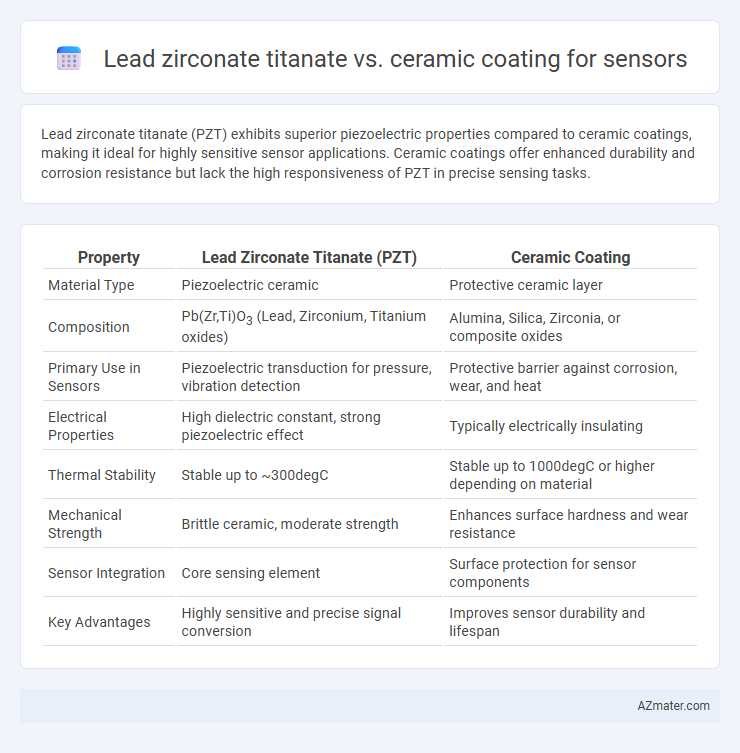Lead zirconate titanate (PZT) exhibits superior piezoelectric properties compared to ceramic coatings, making it ideal for highly sensitive sensor applications. Ceramic coatings offer enhanced durability and corrosion resistance but lack the high responsiveness of PZT in precise sensing tasks.
Table of Comparison
| Property | Lead Zirconate Titanate (PZT) | Ceramic Coating |
|---|---|---|
| Material Type | Piezoelectric ceramic | Protective ceramic layer |
| Composition | Pb(Zr,Ti)O3 (Lead, Zirconium, Titanium oxides) | Alumina, Silica, Zirconia, or composite oxides |
| Primary Use in Sensors | Piezoelectric transduction for pressure, vibration detection | Protective barrier against corrosion, wear, and heat |
| Electrical Properties | High dielectric constant, strong piezoelectric effect | Typically electrically insulating |
| Thermal Stability | Stable up to ~300degC | Stable up to 1000degC or higher depending on material |
| Mechanical Strength | Brittle ceramic, moderate strength | Enhances surface hardness and wear resistance |
| Sensor Integration | Core sensing element | Surface protection for sensor components |
| Key Advantages | Highly sensitive and precise signal conversion | Improves sensor durability and lifespan |
Introduction to Sensor Technologies
Lead zirconate titanate (PZT) is a piezoelectric ceramic extensively used in sensor technologies for its superior electromechanical coupling and sensitivity, making it ideal for pressure, vibration, and ultrasonic sensors. Ceramic coatings, often composed of materials like alumina or zirconia, provide protective layers that enhance sensor durability, thermal stability, and resistance to harsh environments without significantly impacting sensor performance. Choosing between PZT and ceramic coatings depends on application requirements for sensitivity and environmental resilience in advanced sensor systems.
Overview of Lead Zirconate Titanate (PZT)
Lead Zirconate Titanate (PZT) is a piezoelectric ceramic material widely used in sensor applications due to its high dielectric constant and strong piezoelectric response, enabling efficient conversion of mechanical energy into electrical signals. PZT's tunable properties, such as enhanced sensitivity and stability under varying environmental conditions, make it superior to conventional ceramic coatings for precise sensing. Its ferroelectric nature allows for effective signal modulation and improved performance in pressure, vibration, and acoustic sensors.
Understanding Ceramic Coatings in Sensors
Lead zirconate titanate (PZT) is a widely used piezoelectric ceramic in sensors due to its excellent electrical properties and sensitivity. Ceramic coatings in sensors provide enhanced protection against environmental factors such as moisture, temperature fluctuations, and mechanical wear, improving sensor durability and performance. Understanding the role of ceramic coatings helps optimize sensor sensitivity and longevity by maintaining stable electrical characteristics and preventing surface degradation.
Material Properties: PZT vs. Ceramic Coatings
Lead zirconate titanate (PZT) exhibits exceptional piezoelectric properties, high dielectric constant, and excellent electromechanical coupling, making it ideal for sensitive sensor applications requiring precise signal conversion. Ceramic coatings, often composed of materials like alumina or zirconia, provide superior mechanical strength, thermal stability, and wear resistance but generally lack PZT's piezoelectric efficiency. The choice between PZT and ceramic coatings depends on balancing piezoelectric performance with durability and environmental protection in sensor design.
Sensitivity and Performance Comparison
Lead zirconate titanate (PZT) exhibits superior piezoelectric sensitivity compared to conventional ceramic coatings, making it highly effective for precise sensor applications. PZT's enhanced electromechanical coupling coefficient allows for greater signal output and improved frequency response, directly boosting sensor performance. Ceramic coatings, while durable and corrosion-resistant, typically provide lower sensitivity due to their limited piezoelectric properties, restricting their use in high-accuracy sensing environments.
Durability and Environmental Stability
Lead zirconate titanate (PZT) exhibits superior piezoelectric properties and high durability under mechanical stress, making it ideal for sensor applications requiring precise sensitivity. Ceramic coatings offer enhanced environmental stability by resisting corrosion, thermal degradation, and moisture, thus extending sensor lifespan in harsh conditions. Combining PZT with advanced ceramic coatings optimizes sensor durability and environmental resistance, ensuring consistent performance in diverse operational settings.
Application Suitability in Sensor Design
Lead zirconate titanate (PZT) offers superior piezoelectric properties ideal for high-sensitivity sensors in medical ultrasound and precision actuators, enabling efficient energy conversion and precise signal detection. Ceramic coatings, featuring robust chemical and thermal resistance, enhance sensor durability in harsh environments like automotive or industrial applications, protecting sensitive elements from corrosion and wear. Selecting PZT is advantageous for sensors requiring high electromechanical coupling, whereas ceramic coatings are better suited for extending sensor lifespan under extreme operational conditions.
Cost-Effectiveness and Scalability
Lead zirconate titanate (PZT) offers high piezoelectric sensitivity and is widely used in sensor applications, but its manufacturing costs are relatively high due to complex material processing and lead content restrictions. Ceramic coatings provide a more cost-effective alternative with easier scalability, enabling mass production at lower expenses while maintaining adequate durability and environmental resistance. Choosing between PZT and ceramic coatings depends on balancing budget constraints with required sensor performance and volume production needs.
Industry Use Cases and Implementations
Lead zirconate titanate (PZT) is widely utilized in sensor applications across automotive, aerospace, and medical industries due to its superior piezoelectric properties, enabling precise pressure, vibration, and ultrasonic sensing. Ceramic coatings, often composed of aluminum oxide or silicon carbide, provide robust protective layers on sensors for harsh environments, enhancing durability and thermal resistance in industrial manufacturing and oil & gas sectors. PZT is preferred for active sensing elements, while ceramic coatings ensure sensor longevity and reliability in corrosive or high-temperature conditions.
Conclusion: Selecting the Optimal Sensor Material
Lead zirconate titanate (PZT) offers superior piezoelectric properties, making it ideal for high-sensitivity sensor applications requiring precise electrical charge generation. Ceramic coatings provide excellent durability and environmental resistance but generally lack the high piezoelectric coefficients of PZT materials. Selecting the optimal sensor material depends on balancing sensitivity needs with environmental resilience, where PZT excels in performance and ceramic coatings contribute longevity and protection.

Infographic: Lead zirconate titanate vs Ceramic coating for Sensor
 azmater.com
azmater.com